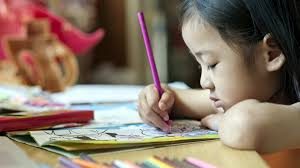Children are naturally drawn to colours. Since they get bored easily, they try to keep themselves occupied any way they can. Whenever a child comes across any writing material, they instinctively pick it up and begin playing with it. Psychologists suggest that the simple act of drawing and colouring can drastically improve a child’s cognitive, emotional, and creative development in the following ways:
Self-Expression
Many children use colouring to express themselves when words fail. A happy child would use bright colours to draw images that are fun and familiar. A sad, upset, or disturbed child would use black to draw gloomy images. This is their way of screaming for help. As a parent and teacher, you should pay close attention to your child’s drawings.

Colour Recognition
Some of the fundamental formal education children learn in school from kindergarten is to recognize colours. With this, they learn to understand the world around them. They associate colours with objects and learn things faster. Colouring materials such as the Disney book collection contains every day objects a child is exposed to. By the time the child has coloured through the entire collection, they would have learned so much about their environment. The Works has a huge stock of various colouring books for children of all ages.
Confidenceand Creativity
The more a child gets positive feedback from their drawings, the more confident they become. As a child becomes more confident, they draw more challenging images, express themselves more freely, and colour boldly. They begin to tell stories using art. Storytelling sparks their creativity beyond imagination. With the completion of an entire colouring book collection, a child feels a sense of accomplishment and responsibility. By simply colouring, the child is able to build confidence through creativity and positive reinforcement.
Hand-Eye Coordination and Handwriting
From the ages of 3 to 6, a child begins learning dexterity and hand strength, both of which are basic grip coordination. With more time practising on colour sheets, they learn to hold crayons and pencils firmly while drawing freely. The basic instruction found in colouring books is that the child must colour within the bounds of a diagram. It also improves their handwriting since all notebooks have rows within which the writing must be done. This forces the child to develop hand-eye coordination skills quickly.
Focus and Comfort
When a child is immersed in a colouring activity, they feel relaxed and at ease. It allows them to focus on achieving their best results. As they grow older, they turn to colouring when they get upset or simply need to relax.
Parent-Child Bonding
Self-expression activities like colouring bring a parent and a child closer. This is an intimate activity for the child, and as a result, they feel a connection when the experience is shared with a loved one.
Colouring should be a fun activity that comes naturally to children. Children that are unable to do any of the above after a prolonged time should be tested by medical professionals. The inability of a child to recognize colours, learn hand-eye coordination, focus and bond with others could be early signs of various forms of cognitive disabilities.

